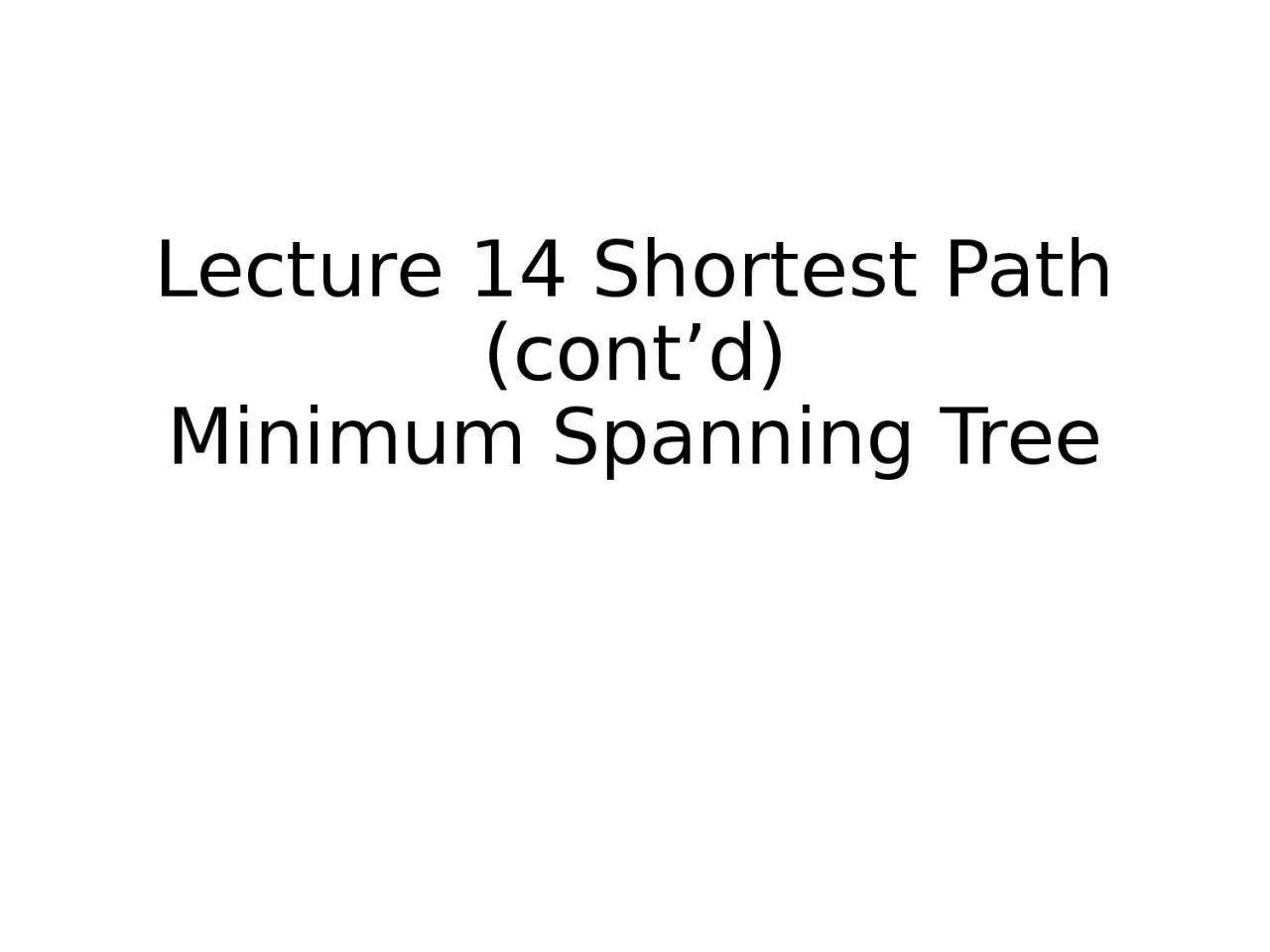

Minimum Spanning Tree Shortest Path with negative edge length What is w uv can be negative Motivation Arbitrage Image from wikipedia Modeling arbitrage Suppose u v are different currency exchange rate is ID: 1001408
Download Presentation The PPT/PDF document "Lecture 14 Shortest Path (cont’d)" is the property of its rightful owner. Permission is granted to download and print the materials on this web site for personal, non-commercial use only, and to display it on your personal computer provided you do not modify the materials and that you retain all copyright notices contained in the materials. By downloading content from our website, you accept the terms of this agreement.
1. Lecture 14 Shortest Path (cont’d)Minimum Spanning Tree
2. Shortest Path with negative edge lengthWhat is w(u,v) can be negative?Motivation: ArbitrageImage from wikipedia
3. Modeling arbitrageSuppose u, v are different currency, exchange rate is C(u,v) (1 unit of v is worth C(u,v) units of u)Let length of edge w(u,v) = log C(u,v)Length of a path = log of the total exchange rateShortest path = best way to exchange money.Negative cycle = arbitrage.
4. Approach: dynamic programming with stepsBellman Ford algorithm:d[u, i] = length of shortest path to get to u with i stepsQuestion: How many steps do we need to take? Shortest Path to a PredecessorLength of last step
5. Naïve implementationSlight modification:d[u, i] = length of shortest path to get to u with at most i steps Initialize d[s, 0] = 0, d[u, 0] = infinity for other uFOR i = 1 to n Initialize d[u, i] = d[u, i-1] for all i FOR all edges (u,v) IF w[u,v]+d[u,i-1] <= d[v,i] THEN d[v,i] = w[u,v]+d[u,i-1]IF there is a vertex such that d[u,n] <> d[u,n-1] THEN There is a negative cycle!
6. How to detect a negative cycle?When the graph has no negative cycle, a shortest path can only contain n-1 edges. (why?)If the graph has a negative cycle, then there is a vertex whose shortest path with n edges is shorter than all paths with at most n-1 edges.
7. Practical ImplementationRunning time:Each iteration takes O(m) time (O(1) per edge)There are n iterations.Total running time O(mn)In practice can be implemented to run efficiently for many graphsOnly consider outgoing edges from u if d[u,i] < d[u,i-1]Use a queue to keep track of which vertices are “updated”
8. Minimum Spanning Tree
9. Minimum Spanning TreeInput: Undirected graph with edge weightsEdge Weight: w[u,v] = cost of connecting two vertices u,vw[u,v] > 0Goal: Select a subset of edges such that every pair of vertices can be connected by these edges. Minimize the total weight of the edges selected.Observation: Only need to select n-1 edges and form a tree.
10. Key Property?Recall: Any sub-path of a shortest path is still a shortest path. Dynamic programming based algorithms.What properties does minimum spanning tree have?
11. Trees and cyclesAdding any non-tree edge to a tree will introduce a cycleFor a tree with a cycle, removing any edge in the cycle results in a tree.Basic operation: add an edge and remove another edge in the cycle created (swap).
12. Why swap?We will use this to give greedy algorithms for MST.Recall: Greedy algorithm, general recipe for proofAssume optimal solution is different from the current solutionTry to find the first place the two solutions differTry to modify OPT so that it looks similar to ALG(use swap here!)
13. Cuts in GraphsA cut is a subset of edges that separates the vertices into two partsA cut is usually specified by a subset of vertices, S is one part of the vertices, is the set of remaining vertices.
14. Question for the greedy algorithmGiven a cut, which edge should we use?Idea: Use the shortest one (with minimum cost).(Note: Eventually we may use multiple edges in the cut, this only decides which is the first edge we use)
15. Key PropertyKey Lemma: Suppose F is a set of edges that is inside some MST T, if is a cut that does not contain any edge in F and e is the minimum cost edge in the cut, then it is safe to add e to F. for some MST T’
16. General Algorithm for MSTInitialize the tree to be empty.(initially a subset of some MST)Repeat Find a cut that does not have any edge in the current tree Add the min cost edge of the cut to the tree(by Key Lemma: still a subset of some MST)Until the tree has n-1 edges(Now we already have a tree, so it must be a MST)